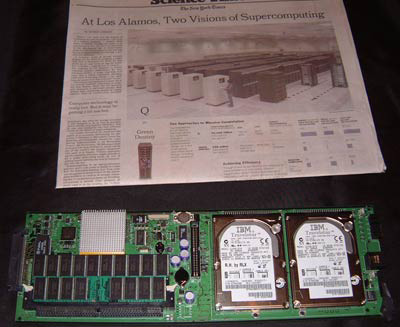The event was certainly geared towards the flashier Cruse-based devices
like notebooks and tablet PC's, but at least one blade server was on display.
Literally measuring about the same size as a newspaper, the RLX Technologies
Razor 324 bladeserver is quite a sight to behold.
When mounted in a proprietory 3U 19" server chassis, up to 24 blade servers
can be run independently, resulting in incredibly dense servers and large power
savings.
RLX have since launched the serverblade 800i, powered by a low voltage
Intel Pentium III processor but the Crusoe based server blade shown here is
what we are interest in. A similar bladeserver, along with 239 other units were
recently used in a Beowolf cluster dubbed Green Destiny by researchers at
researchers at Los Alamos National Laboratory. While the low power requirements,
and low thermals of the Crusoe processor make it an excellent processor for
improving the economics of large scale IDC's there are factors also preventing
the growth. According to an article on IDG, blade servers only accounted for
11.5million in revenue in the first quarter of 2002.

Other limiting factors surround the Crusoe processor more directly - the
serverblades work as webservers, but don't have the muscle required to
tackle more intensive tasks like databases or true SMP. Looking back in history,
the picture is murky at best, with two companies originally announcing
competing Crusoe-based blade servers in 2001. The second company, FiberCycle
Networks, has since filled for Chapter 7 Bankruptcy leaving
everyone to wonder if Crusoe based servers will flurish in the future, or end up
a white elephant.
The Bladeserver 667 shown here features a TM5600 Crusoe processor, two 20GB
ATA66 harddrives, 128MB of onboard DDR, three embedded 10/100 NICS, and retails
for about $1200USD. The Bladeserver 667 has been benchmarked at ~1360 webpages
per second.
